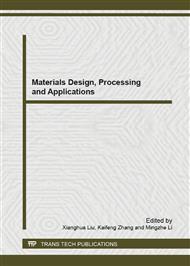[1]
V. Kovařík: Use of reverse engineering for creation of spare part to printer. [Diploma thesis]. - Slovak university of Technology in Bratislava. Faculty of Materials Science and Technology in Trnava, Institute of Production Technologies. – Supervisor: Ing. Ivan Buranský, PhD., MTF STU Trnava (2012), 113 p.
DOI: 10.17973/mmsj.2021_12_2021128
Google Scholar
[2]
I. Budak, D. Vukelić, D. Bračun, J. Hodolič, M. Soković: Pre-Processing of Point-Data from Contact and Optical 3D Digitization Sensors. Sensors (2012) 12, pp.1100-1126, ISSN 1424-8220
DOI: 10.3390/s120101100
Google Scholar
[3]
R. Racasan, D. Popescu, C. Neamtu, M. Dragomir: Integrating the concept of reverse engineering in medical applications. 2010 IEEE International Conference on Automation, Quality and Testing, Robotics, AQTR 2010, 28-30 May 2010, Cluj-Napoca, Romania. Vol. 2, art. no. 5520710, pp.352-356
DOI: 10.1109/AQTR.2010.5520710
Google Scholar
[4]
A. Fodor, P. Boza, N. Földvári: Three-dimensional surfaces (car-body tools) in 3D and 5D-bite test was carried out. ICT-2012 13th International Conference on Tools, 27 – 28 March 2012, Miskolc, Hungary, Published by the Department of Production Engineering, University of Miskolc, ISBN 978-963-9988-35-4, (2012), pp.47-54
Google Scholar
[5]
C.S. Borzan, P. Berce, A.V. Miron, , A.I. Hodor, V.A. Ceclan: Some considerations about manufacturing of custom implants from biocompatible materials. 13th Interntational Scientific Conference "Automation in Production Planning and Manufacturing", 2-4 May 2012, Žilina – Turčianske Teplice, Slovak Republic. edited by I. Kuric, ISBN 978-80-89276-35-6, pp.32-35. Published by Scientific and Technical Society at the University of Žilina (2012).
DOI: 10.4028/www.scientific.net/amm.808.169
Google Scholar
[6]
D. Damjanović, D. Kozak, M. Živić, Ž. Ivandić, T. Baškarić: CFD analysis of a concept car in order to improve aerodynamics. A jövő járműve - Járműipari innováció, Vol. 5, (2011), 1–2, pp.63-70., HU ISSN 1788-2699. X-Meditor Lapkiadó, Oktatás és Rendezvényszervező Kft., Győr
Google Scholar
[7]
Yonghua Chen - Jianan Lu: Sub-surface Cutting for Rapid Prototyping. Advanced Materials Research Vols. 479-481 (2012) pp.561-564., Trans Tech Publications, Switzerland
DOI: 10.4028/www.scientific.net/AMR.479-481.561
Google Scholar
[8]
Web page of Applied Rapid Technologies (ART) Corp. Poly-Jet Modeling scheme: http://www.artcorp.com/polyjet_process2.jpg (01 December 2012)
Google Scholar
[9]
P. Bere, P. Berce, O. Nemes: Phenomenological fracture model for biaxial fibre reinforced composites. Composites: Part B (2012)
DOI: 10.1016/j.compositesb.2012.01.073
Google Scholar
[10]
L. Lăzărescu, D-S. Comşa, D. Banabic: Analytical and Experimental Evaluation of the Stress -Strain Curves of Sheet Metals by Hydraulic Bulge Tests. Key Engineering Materials Vol. 473 (2011) pp.352-359
DOI: 10.4028/www.scientific.net/KEM.473.352
Google Scholar
[11]
Hsin-Te Liao, Le Manh Trung: Optimization on selective fiber laser sintering of metallic powder. Advanced Materials Research Vols. 472-475 (2012) pp.2519-2530, Trans Tech Publications, Switzerland
DOI: 10.4028/www.scientific.net/AMR.472-475.2519
Google Scholar
[12]
R. Pacurar, A. Pacurar, P. Berce, N. Balc, O. Nemes: Porosity Change by Resin Impregnation in Structures Obtained by Selective Laser Sintering Technology. Studia Universitatis Babes-Bolyai Seria Chemia, Vol. 3, 2012, ISSN 1224-7154 printed edition, ISSN 2065-9520 online edition - http://chem.ubbcluj.ro/~studiachemia/
DOI: 10.24193/subbchem
Google Scholar


